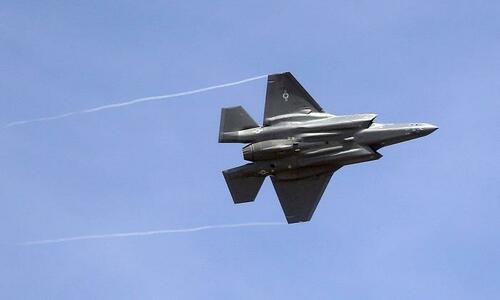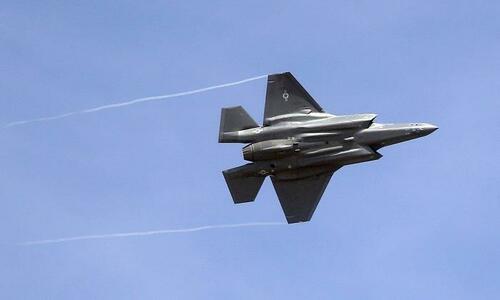Despite 400% Cost Increase And Poor Reliability, F-35 Approved For Increased Production Rate
Authored by Mike Fredenburg via The Epoch Times,
After more than 900 F-35s being delivered under so-called low-late production, the Pentagon has authorized the F-35 for full-rate production that will eventually deliver more than 2,400 planes.
This huge milestone in the F-35 program, achieved after 30 years of development, was attained by passing the initial operational testing conducted by the office of the Director of Operational Test and Evaluation (DOT&E).
Given the F-35’s soaring costs and significant reliability and performance issues, skepticism about the results and/or interpretation of the DOT&E testing results seems wise.
A 400 Percent Increase In Program Cost
Speaking of soaring costs, a just-released GAO report now estimates that the F-35 program will cost $2 trillion over the life of the program, which improbably has the F-35 flying till 2088. This represents a 15 percent increase over the previous $1.7 trillion dollar estimate. But if you confine yourself to the last few years, you miss out on how truly awe-inspiring the cost growth of the program has been. Indeed, the 2007 GAO F-35 program report states that the “DOD is expected to develop, procure, and maintain 2,443 aircraft at a cost of more than $338 billion over the program’s life cycle.” This is $508 billion in 2024 dollars. So, from 2007 to now, the program cost has increased by 400 percent.
But the $2 trillion topline cost doesn’t tell the whole picture, as getting to that number requires reducing the number of hours each F-35 flies per year by 21 percent on average. While reducing stick time for pilots will certainly reduce costs for the maintenance-intensive F-35, it is an awful way to do so as it will inevitably result in less-experienced, less-capable pilots who could end up paying the ultimate price due to inadequate training.
Further, for such an accounting trick to have any chance of succeeding in keeping costs down, we must count on our enemies not to engage in actions that force us to use our F-35s more than their meager estimated 8 to 10 hours of allotted flight hours per month.
F-35 Sustainment Cost Driven By High Maintenance Costs
The vast majority of the 400 percent increase in F-35 program costs come from the cost of sustainment. Moreover, a major factor driving sustainment has been the F-35’s lack of reliability. This lack of reliability has many causes.
For example, the F-35 depends on millions of lines of software code to provide its claimed capabilities. If you read through the DOT&E reports of years gone by, you find that rolling out software-enabled capabilities has consistently been overbudget, behind schedule, and riddled with bugs. A 2016 memo by former DOT&E Director Michael Gilmore documents some of these issues. Sadly, I have seen nothing in the intervening years that convinces me that a software development process that at times devolved into programming over the top of buggy code in order to create the impression of meeting deadlines has been fixed.
Consequently, it is my belief that the F-35 software is still full of bugs and that the plan is to eventually fix these bugs by using some of the funding from the endless stream of modernizations and new threat upgrades that the F-35 program will consume to fix bugs that should have been fixed before full-rate production was approved. And make no mistake, over the next 10 years these “upgrades” will add up to many billions of dollars.
However, with enough billions of dollars and years of effort, it is conceivable that buggy code could be made more reliable, but the same cannot be said for the super-hot running F-35’s overtaxed Pratt & Whitney F135 engine, which is reportedly incapable of providing the necessary cooling for the energy-hungry Block 4 upgrades the Pentagon claims will finally allow the F-35 to show its true worth.
Sure, by flying less hours, the F135 engines won’t fail as quickly. Sure, there are plans to spend tens of billions to upgrade the engines, but until the new engine core upgrades that are still in the process of being designed are fielded and subjected to years of use, we won’t know how reliable they will be. Hence, given the immediate lack of reliable engines and no prospect of having reliable engines for at least the next five years, the F-35 should not have been authorized for full-rate production.
To top things off, the previously mentioned Block 4 upgrades considered so necessary to achieving the F-35’s promised capabilities have been delayed until 2025 due to the need for additional testing.
All of this adds up to what appears to be a work in progress that might or might not have reliable engines powerful enough to do the job sometime in the future. And with highly complex, high-maintenance, dreamed-up capabilities and technologies that have yet to demonstrate their value in any real-life combat situation, the F-35 does not inspire confidence.
Further, all the evidence suggests that the F-35 sortie generation rate will be vastly inferior to combat-proven planes like the F-16 and the A-10 that over the years have been modernized/upgraded to feature state-of-the-art technology. And let’s not forget the F-35 Joint Strike Fighter has been in development since 1994, and that U.S. taxpayers have already spent more than $300 billion on it.
This begs the question of how the F-35 was certified for full-rate production even while its very expensive combat capabilities are not yet ready for real-life testing (simulations don’t count) and the F-35’s full mission capability rate could be as low as 30 percent. We don’t know the answer because the DOT&E testing report is not available to the taxpaying public.
What we do know is that the F-35’s overall reliability is poor, its engine is inadequate, it can’t do close air support, its within-visual-range dogfighting is mediocre at best, its range while carrying a full weapons loadout in “Beast Mode” is poor, and because of its ongoing weight issues, key safety equipment was removed from it, making it arguably the most fragile plane in the U.S. fighter inventory. Given these facts, its recent certification warrants a large dose of skepticism.
Finally, does anyone really believe the $2 trillion program cost is the final word or that new engine cores will be ready to go in 2029?
Tyler Durden
Fri, 06/14/2024 – 12:15


